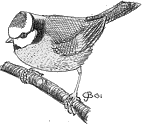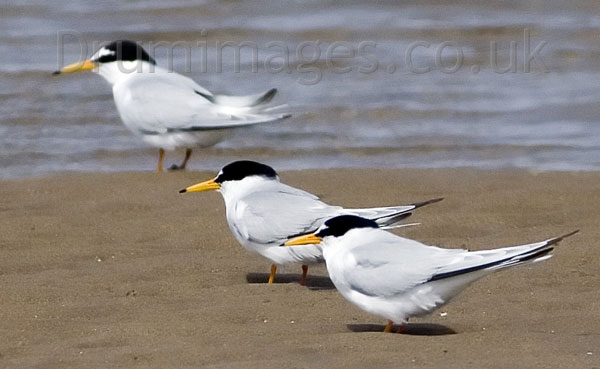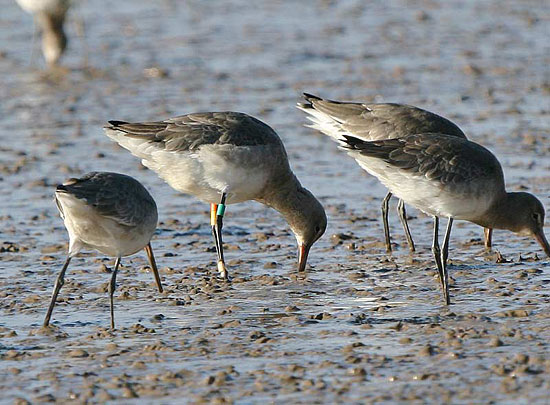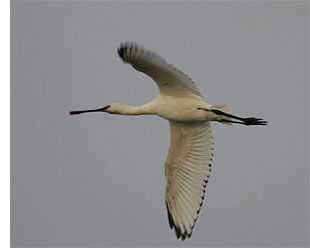Site menu:

March 2009 Newsletter
Highlights - March 08 to Feb 09.
Appeal for Voluntary Wardens - Neston Reedbed.
Jan and Feb Bird News.
Forthcoming Events.
Latest Newsletter.
Highlights - March 2008 to February 2009
As usual my review of the year starts in March because this website first started in March, 11 years ago.
The highlight of March 2008 was undoubtedly the big high tide on the 10th which swept over the marshes bringing a total of 21 Water Rails along the front at Parkgate as well as six Short-eared Owls and the usual great views of waders, wildfowl and assorted rodents. As it turned out that was the only tide that did cover the marsh for the whole year.
 The
spring migration started early with a White Wagtail on March 9th, otherwise
the dates of early arrivals were similar to 2007. There were good numbers
of Stonechats passing through with 22 on March 14th, there were two counts
of 40 Wheatear and one of 25 White Wagtail, all in April. Raptors included
eight reports of Marsh Harriers, six Ospreys and a couple of Hobbies.
Cuckoos are now rare in our area so it was nice to get reports of seven in
April and May. After the influx of Cattle Egrets into the country over the
previous winter the one which turned up on the
Hoylake Langfields in April
almost seemed common place, but it was only the third record for Wirral.
Other rarities during the spring included a Bluethroat on
Hilbre, which
stayed for one day in May, and two Red-rumped Swallows. A Cetti's Warbler
was present in the Neston Old Quay area during the spring. Photo above: Bluethroat on Hilbre by Steve Williams
The
spring migration started early with a White Wagtail on March 9th, otherwise
the dates of early arrivals were similar to 2007. There were good numbers
of Stonechats passing through with 22 on March 14th, there were two counts
of 40 Wheatear and one of 25 White Wagtail, all in April. Raptors included
eight reports of Marsh Harriers, six Ospreys and a couple of Hobbies.
Cuckoos are now rare in our area so it was nice to get reports of seven in
April and May. After the influx of Cattle Egrets into the country over the
previous winter the one which turned up on the
Hoylake Langfields in April
almost seemed common place, but it was only the third record for Wirral.
Other rarities during the spring included a Bluethroat on
Hilbre, which
stayed for one day in May, and two Red-rumped Swallows. A Cetti's Warbler
was present in the Neston Old Quay area during the spring. Photo above: Bluethroat on Hilbre by Steve Williams
5,500 Common Scoter off north Wirral in April was a fantastic sight, 4,000 were still there in early May, along with a couple of Velvet Scoters.
It was a very good year for terns. First a Whiskered Tern turned up at Inner Marsh Farm in May where it stayed 10 days, a first for Wirral. September brought a White-winged Black Tern to Shotwick Boating Lake, a couple of Black Terns were present at the same time. Black Terns were also seen a few times during the summer, there were eight records in August including three off Hilbre and Red Rocks. Single Roseate Terns were reported in July and September. Of the commoner species the maximum count of Little Terns at Gronant was 340, which will have included some non-breeding birds. It was another good breeding season here with 104 chicks fledged. There was an intriguing tern at Gronant in July, a Sandwich Tern sized bird with an orangey-yellow bill, possibly a Lesser Crested Tern or some sort of hybrid, the latter more likely. Unfortunately this bird only stayed a short time, before it could be properly identified. As usual Sandwich Tern numbers built up rapidly post breeding with at least 2,000 in the estuary, despite another disastrous breeding season at Cemlyn Bay (Anglesey) we saw good numbers of juveniles in the flocks here which indicates that these birds breed elsewhere - probably Ireland. Although the number of Common Terns breeding at Shotton was slightly down on the previous year there were large numbers in the estuary with 1,000 counted from Hilbre and many more elsewhere.

There was some good sea watching through the year. As well as the Scoters already mentioned there was a max daily count of 165 Little Gulls off Hilbre in April, and an early Arctic Skua on April 20th. A June gale resulted in a remarkable 800 Gannets flying past Hilbre, 79 Manx Shearwaters were counted on the same day. 31 Storm Petrels off New Brighton during strong winds on July 20th was an excellent count and the highest for the year. Great, Pomarine and Arctic Skuas were all seen in August, max count of Arctic Skuas was 14 off Hilbre on 28th. Strong winds on August 19th resulted in a count of 233 Manx Shearwaters past Red Rocks. It wasn't until October 1st before we got any autumn gales, these blew in 120 Leach's Petrels past Hilbre, with 107 the following day, along with Long-tailed, Pomarine and Great Skuas, Sabine's Gulls and Grey Phalaropes. Gales in November saw 2 Leach's Petrels and 1 Storm Petrel off Hilbre on the very late date of Nov 21st.
Divers reported included 78 Red-throated and a Black-throated off Hilbre on Feb 11th. Earlier in the winter a Great Northern Diver frequented West Kirby Marine Lake for a month from mid-Nov to mid-Dec, it was presumably the same bird which was observed from Hilbre several times over the same period. Numbers of Great Crested Grebes off north Wirral remained high with max monthly counts as follows: 214 in September, 435 in December, 158 in January, 104 in February (no counts in Oct or Nov). The count on Dec 15th is the second ever highest count for Cheshire and Wirral.
The winter which has just finished has seen some some remarkable numbers of Short-eared Owls, Hen Harriers and Brent Geese. It must have been a great year for voles on the marshes as we had 30 or more Short-eared Owls in November, numbers have probably dropped through the winter but right at the end of February we had a count of 33, 27 at Burton and six at Parkgate. After a poor winter for Hen Harriers in 07/08 this winter has seen a return to numbers not seen since 1981. We've had at least twice well authenticated counts of six coming into roost at Parkgate, compromising an adult male, a sub-adult male and four ringtails, three or four birds were regular throughout the winter. There was a report of eight coming into roost in February but there has to be big question mark over that one as there was the likelihood of double counting. Another exciting raptor was a well observed Rough-legged Buzzard at West Kirby and Hilbre in November. Brent Geese numbers keep on increasing, the two highest counts of the winter came when the flock was split at high tide between Little Eye, West Kirby and Bird Rock (Red Rocks); 171 on January 11th and 208 on January 28th, the next highest count was of 168 on Hilbre on Christmas Day.

Wader numbers throughout the past 12 months were generally unremarkable. Highlights included a max of 18 Avocets at Inner Marsh Farm in the spring, several pairs bred but unfortunately all the resulting chicks were predated. I understand that as part of the exciting developments at Inner Marsh Farm a fence will be built around the reserve, keeping out the foxes. There were good numbers of Black-tailed Godwits during the late summer and autumn with over 770 at Gilroy Nature Park, West Kirby, and similar numbers at Inner Marsh Farm, these provided roosting and fresh water feeding sites for some of the several thousand birds present on the estuary. Colour ringing of these godwits continue to feed back fascinating information about the movement of these birds.
 Other
interesting birds over the past 12 months include several reports of single
Spoonbills plus three at Connah's Quay in September, three White Storks
were reported over the estuary one day in April and a Glossy Ibis was at
Inner Marsh Farm on July 16th and 17th. A Bittern was observed on
Parkgate
Marsh several times in Jan and Feb. 2008/09 was a good Waxwing winter
across the country. Here we only had a few which never stayed for long,
until 13 Waxwings arrived at Wepre Park and stayed for two weeks in January
giving some great views - unfortunately spoilt by a handful of pushy
photographers who got far too close to the birds.
Other
interesting birds over the past 12 months include several reports of single
Spoonbills plus three at Connah's Quay in September, three White Storks
were reported over the estuary one day in April and a Glossy Ibis was at
Inner Marsh Farm on July 16th and 17th. A Bittern was observed on
Parkgate
Marsh several times in Jan and Feb. 2008/09 was a good Waxwing winter
across the country. Here we only had a few which never stayed for long,
until 13 Waxwings arrived at Wepre Park and stayed for two weeks in January
giving some great views - unfortunately spoilt by a handful of pushy
photographers who got far too close to the birds.
Right: Spoonbill at Inner Marsh Farm RSPB on Sept 12th, Mark Evans.
Voluntary Wardens Needed to Protect Neston Reed Bed

Once again the RSPB are organising voluntary wardening at Neston Reed Bed, the scheme will begin March 28th and run through until the end of May. Wardening will take place each evening in order to protect this important habitat from disturbance. I know in the past this scheme has attracted birders who have realised what a good opportunity this location is for some serious birdwatching with the possibility of seeing migrating Ospreys and Marsh Harriers, large numbers of Little Egrets flying in to roost, Bearded Tits, Hen Harriers, Short-eared Owls and the numerous birds which breed in the reed bed. If you are interested please contact Geoff Robinson (Geoffrey.Robinson@rspb.org.uk), telephone 0151 336 7681.
January and February Bird News
The year started rather bizarrely with a Woodcock sitting on top of the groyne by the Life-guard Station at Wallasey, surrounded by the sea! This species is normally found in woodland. At nearby New Brighton an adult Mediterranean Gull took up residence, by the end of February it had obtained it's full summer plumage (it hadn't quite reached full s/pl in the photo below). There appears to be an increasing numbers of Purple Sandpipers roosting on a float on New Brighton Marine Lake at high tide, max count was 22 on Feb 10th.

Although it was nice to have had some Waxwings staying for 10 days at Wepre Park, Connah's Quay, it was a pity that many people's enjoyment was spoilt by the behaviour of a few selfish photographers - see last month's newsletter!!!!
We had two reliable reports of six Hen Harriers coming into roost at Parkgate, the highest number since 1981. Unfortunately the report of eight on Feb 11th may have to be ruled out as there is the possibility (probability?) that two or three birds slipped away from the roost unseen only to return later to be double counted, as they are prone to do. Most reports were of three to five birds. A Marsh Harrier has been noted a few times over the past two months. Also on the marshes Short-eared Owl numbers remained high. Max count on Burton Marsh was a remarkable 27 on Feb 28th, and off the Old Baths at Parkgate max was 11 on Jan 5th. Those at Parkgate gave particularly good views with hissing and wing clapping observed. A Bittern was recorded at Parkgate off the Old Baths on Jan 25th and was seen several times during February.
 There
have been three very high counts of Brent Geese this winter: 168 on Christmas
Day, 171 on Jan 11th and a record breaking 208 on Jan 28th. The large majority
of these are the pale-bellied race the majority of which winter in Ireland.
Pintail have been present in increasing numbers off
Thurstaston with a max of
1,103 on Jan 5th, at least 2,000 were off the Connah's Quay Reserve on Jan 14th.
Also at Thurstaston there have been large numbers of Black-tailed Godwits, up to
2,000 since before Christmas. A total of 23 colour ringed birds have been
recorded since the beginning of the year yielding some fascinating details of
their movements.
There
have been three very high counts of Brent Geese this winter: 168 on Christmas
Day, 171 on Jan 11th and a record breaking 208 on Jan 28th. The large majority
of these are the pale-bellied race the majority of which winter in Ireland.
Pintail have been present in increasing numbers off
Thurstaston with a max of
1,103 on Jan 5th, at least 2,000 were off the Connah's Quay Reserve on Jan 14th.
Also at Thurstaston there have been large numbers of Black-tailed Godwits, up to
2,000 since before Christmas. A total of 23 colour ringed birds have been
recorded since the beginning of the year yielding some fascinating details of
their movements.
Above: Knot on Meols Shore Feb 6th, © Richard Steel.
Pink-footed Geese numbers on the estuary appear to be increasing with up to 600 over-wintering birds out on the marshes this winter. The 700 which flew north over West Kirby on Jan 12th were probably part of a movement between Norfolk and Lancashire.
The Twite which were present in December at Thurstaston remained for most of the last two months, down to 12 from 13, but they appeared to get more elusive as time went on. A few Snow Buntings have been around with eight at Point of Ayr on Jan 25th the highest number. A good but brief view was had of a Bearded Tit near Decca Pools on Feb 18th.
Richard Smith.
What to expect in March
Spring is always an exciting time for birdwatchers with the arrival of the first spring migrants. Below is a table showing the first dates for some of our commoner summer visitors, as you see some years we have to wait until well into the third week of March before they start coming though. I particularly look forward to seeing Wheatears, they are often the first to arrive and once they do they just keep on coming. Don't forget to tell me if you see any early arrivals and I'll put the details in the next newsletter.
| Species | 2008 | Location (08) | 2007 | 2006 |
|---|---|---|---|---|
| White Wagtail | 9th March | Leasowe | 13th March | 19th March |
| Wheatear | 13th March | Denhall Quay | 12th March | 23rd March |
| Swallow | 15th March | Hilbre | 16th March | 25th March |
| Sand Martin | 16th March | Inner Marsh Farm | 15th March | 26th March |
| Willow Warbler | 31st March | West Kirby | 3rd April | 31st March |
| House Martin | 11th April | West Kirby | 1st April | 29th March |
| Whitethroat | 11th April | Heswall | 15th April | 17th April |
| Swift | 22nd April | Leasowe | 16th April | 16th April |
| Cuckoo | 23rd April | Inner Marsh Farm | 15th April | 29th April |
There are some more big spring tides forecast this month, on the 10th, 11th and 12th. Last year the tide fairly roared in over the marsh on the 10th giving spectacular views of Water Rails, Short-eared Owls and the usual waders and wildfowl. How far it actually comes in depends on the weather, a strong west wind and low atmospheric pressure is hoped for!

Out to sea we should see our first Gannets of the year, and maybe an early Sandwich Tern or two. Little Gulls will be on their way north, particularly towards the end of the month. As well as Hilbre a good place to see these is at New Brighton, particularly during a strong north-west wind. We might also see large numbers of Common Scoter, they are often so far out to sea that they are not visible - until a boat sails near to them putting them all up.
RSPB Recent Sightings: recent bird sightings from Inner Marsh Farm, Parkgate and Point of Ayr RSPB Reserves can be seen on the RSPB website (as well as this website!), go to http://www.rspb.org.uk/reserves/guide/d/ then click on the link to the appropriate reserves.
Forthcoming Events
March Highest Spring Tides (Liverpool)
Also see
Tides page.
11th March, 11.20hrs (GMT), 9.9m.
12th March, 12.00hrs (GMT), 10.0m.
13th March, 12.38hrs (GMT), 9.8m.
Forthcoming Events
Organised by the
Wirral Ranger Service ,
Flintshire Countryside Service and/or the RSPB:
All these events and walks have bird interest, even those not advertised
specifically for birdwatching. No need to book for these events unless
specified - please check below.
Sunday 1st March 10:00hrs to 12:00hrs
Birds in the Bush - Royden Park
Join the Ranger and discover the bird-life that frequents our trees,
bushes and heathland on a walk at Royden Park and Thurstaston Common.
Suitable for all the family to enjoy. All children under 8yrs must be
accompanied by an adult. Sorry no dogs.
Meet at Rangers' Office, Royden Park, CH48 1NP
For further enquiries call: 0151 677 7594
Thursday 12th March 2009 9am start
Marsh Matters
Join the Rangers at Riverbank Rd (Lower
Heswall) car park to watch over the Dee Marshes as
the tide sweeps in.
Watch for waders, ducks, raptors and maybe an elusive Water Rail or two!
No need to book, meet at Riverbank Rd car park, Lower Heswall (HW 1200hrs,
10.0m).
For more info: (0151) 648 4371/3884
Thursday 12th March 10.30am
Parkgate Birdwatch
High tide at Parkgate is the best time to discover the hidden treasures of
the Dee Estuary RSPB reserve. If the tide reaches the wall, small mammals
such as voles, shrews and possibly water rails are flushed out. Meet at
the Old Baths car park overlooking the reserve at Parkgate, close to The
Boat House pub (HW 1200hrs, 10.0m). No need to book.
Saturday 14th March 2009, 10am to 4pm.
Wonderful Winter Wildfowl and Waders.
RSPB staff and volunteers will be in the car park at the north end of the Wirral
Peninsula overlooking West Kirby Marine Lake with telescopes and binoculars to
provide visitors with crystal clear views of the birds and other
wildlife. There will be a wealth of information to offer visitors, plus the chance to
send for a free ‘homes for wildlife’ pack that explains what people can do
in their own gardens, however small, to help birds and wildlife. This is a
joint event with the RSPB, Wirral Ranger Service and Dee Estuary Voluntary
Wardens. For more information ring 0151 336 7681.
Saturday 14th March, 10am – 3pm, Connah’s
Quay Reserve Open Day.
Join the Deeside Naturalists Society for some spectacular, hightide
birdwatching (HW: 9.6m, 13.14pm). Location: From A548 take the Connah’s
Quay turn, and follow the Power Station
signs. A member of the society will greet you at the reserve entrance.
Further information: D.N.S. - 01244 537440. Also see
www.deesidenaturalists.org.uk.
Sunday 15th March, 10am start.
Up Hill Down Dale.
Join the Ranger for a guided walk over heathland and woodland including
part of the Wirral Way. Please wear suitable clothing and footwear.
Suitable for all the family to enjoy,. Sorry no dogs.
Meet at Dale Farm entrance on Oldfield Road, off Quarry Road West, Heswall,
CH60 6SN.
For further enquiries call: 0151 677 7594.
Saturday 21st March, 06:30hrs - 08.30hrs.
Woodland Wildlife.
The woods are just waking up after their winter slumber and birds and
mammals are on the move! With the leaves not yet out now is a great time to
have a walk in the woods. We'll look for woodpeckers, small mammals and
early wild flowers on our mooch around
Stapledon Woods. Don't forget your binoculars! Sorry no dogs.
Booking Essential, ring 0151 648 4371.
Sunday 22nd March 3pm start.
Parkgate Raptor Watch
Come along and watch birds of prey with the experts. See the graceful hen
harriers coming in to roost on the RSPB reserve. Other birds of prey we
hope to see are merlin, peregrine, sparrowhawk, short-eared owl and
barn owl. Meet at the Old Baths car park, which overlooks the Dee Estuary
RSPB Reserve at Parkgate, close to The Boat House pub. No need to book.
Saturday 28th March 2009, 10am to 4pm.
Wonderful Winter Wildfowl and Waders.
RSPB staff and volunteers will be in the car park at the north end of the Wirral
Peninsula overlooking West Kirby Marine Lake with telescopes and binoculars to
provide visitors with crystal clear views of the birds and other
wildlife. There will be a wealth of information to offer visitors, plus the chance to
send for a free ‘homes for wildlife’ pack that explains what people can do
in their own gardens, however small, to help birds and wildlife. This is a
joint event with the RSPB, Wirral Ranger Service and Dee Estuary Voluntary
Wardens. For more information ring 0151 336 7681.
Saturday 25th April, 9.30am start.
Migrants at Point of Ayr.
Join the RSPB experts this morning for a spot of birdwatching
(HT 12.00, 9.4m). Further information: RSPB – 0151 3367681.
Meeting point: Smugglers Inn car park. Free.
|
 |
The blank (UK) Birding Webring is a collection of quality birding web sites that are based in the United Kingdom. Visit the webring homepage for more information, or A complete list of all the sites in the webring is available by clicking here. previous site in ring : random site in ring : next site in ring |